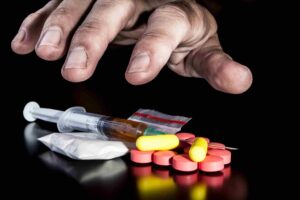In recent years, opioid addiction has emerged as a significant public health crisis, affecting millions of individuals and families worldwide. What starts as a legitimate prescription for pain relief can quickly spiral into a debilitating addiction, wreaking havoc on physical health, mental well-being, and social relationships. Understanding the complexities of opioid addiction is crucial for effective prevention, treatment, and support. In this blog, we’ll delve into the causes, consequences, and potential solutions surrounding this pressing issue.
Contents
What Is Opioid Addiction?
 Opioid addiction, often referred to as opioid use disorder (OUD), is a chronic and complex condition. It is characterized by the compulsive use of opioid drugs despite negative consequences. Opioids are a class of drugs that include prescription pain relievers like oxycodone, hydrocodone, and morphine, as well as illegal drugs like heroin.
Opioid addiction, often referred to as opioid use disorder (OUD), is a chronic and complex condition. It is characterized by the compulsive use of opioid drugs despite negative consequences. Opioids are a class of drugs that include prescription pain relievers like oxycodone, hydrocodone, and morphine, as well as illegal drugs like heroin.
Addiction to opioids typically develops when individuals misuse these substances, either by taking them without a prescription, taking larger doses than prescribed, or using them in ways other than intended. At its core, opioid addiction hijacks the brain’s reward system, leading to a powerful craving for the drug and a diminished ability to control its use.
What Are The Symptoms To Know?
Recognizing the symptoms of opioid addiction is crucial for early intervention and support. Here are some common signs and symptoms to look out for:
- Increased Tolerance: Individuals may require higher doses of opioids to achieve the same effects they once experienced with lower doses. This tolerance development can lead to escalated drug use.
- Withdrawal Symptoms: When opioid use is reduced or stopped, withdrawal symptoms such as nausea, vomiting, diarrhea, sweating, anxiety, and muscle pain may occur. These symptoms can be highly uncomfortable and often drive individuals to continue using opioids to avoid withdrawal.
- Loss of Control: People with opioid addiction often find it challenging to control their drug use, even when they want to stop or cut back. They may spend a significant amount of time obtaining, using, and recovering from the effects of opioids.
- Neglecting Responsibilities: Opioid addiction can lead to neglect of responsibilities at work, school, or home. Individuals may struggle to meet deadlines, fulfill obligations, or maintain relationships due to their preoccupation with obtaining and using opioids.
- Changes in Behavior: Mood swings, irritability, and changes in social circles or activities can indicate opioid addiction. Individuals may also exhibit secretive behavior, lying about their drug use or whereabouts.
- Physical Changes: Chronic opioid use can lead to physical changes such as constricted pupils, weight loss, or changes in sleep patterns. Track marks or needle puncture sites may be visible in individuals who inject opioids.
- Financial Problems: Maintaining an opioid addiction can be costly, leading individuals to borrow money, steal, or engage in other illegal activities to fund their drug use.
Recognizing these symptoms and behaviors in oneself or a loved one is a crucial first step toward seeking help and support for opioid addiction.
Who Is Vulnerable To Opioid Addiction?
 Several factors contribute to an individual’s vulnerability to opioid addiction:
Several factors contribute to an individual’s vulnerability to opioid addiction:
- Genetics
Genetic predispositions can play a significant role in determining an individual’s susceptibility to addiction. Certain genetic variations can affect how the body metabolizes opioids and how the brain responds to their effects, influencing the likelihood of developing addiction.
- Mental Health Disorders
Co-occurring mental health disorders, such as depression, anxiety, or post-traumatic stress disorder (PTSD), can increase the risk of opioid addiction. Individuals may use opioids as a form of self-medication to alleviate symptoms of psychological distress, leading to dependency and addiction.
- Chronic Pain
People with chronic pain conditions are often prescribed opioids for pain management. Prolonged use of these medications can increase the risk of developing tolerance, dependence, and ultimately addiction. The cycle of pain and relief provided by opioids can reinforce addictive behaviors.
- History of Substance Abuse
Individuals with a history of substance abuse, whether it involves opioids or other drugs, are at a higher risk of developing opioid addiction. Prior exposure to addictive substances can alter brain chemistry and increase susceptibility to addiction.
- Early Exposure to Opioids
Exposure to opioids at a young age, whether through prescribed medications or experimentation, can increase the likelihood of developing addiction later in life. Adolescents and young adults are particularly vulnerable to the addictive effects of opioids due to ongoing brain development.
Understanding these risk factors is essential for identifying individuals who may be at heightened risk of opioid addiction. And implementing targeted prevention and intervention strategies to mitigate potential harm.
What Are The Opioid Withdrawal Treatments?
Opioid withdrawal treatment aims to alleviate the uncomfortable symptoms of withdrawal while supporting individuals through the detoxification process.
Medical approaches
Here are several approaches commonly used in opioid withdrawal treatment:
Medication-Assisted Treatment (MAT)
MAT combines medication with behavioral therapy and counseling to address opioid addiction comprehensively. Medications such as methadone, buprenorphine, and naltrexone are commonly used to manage withdrawal symptoms, reduce cravings, and prevent relapse.
Methadone
Methadone is a long-acting opioid agonist that helps alleviate withdrawal symptoms and reduce cravings without producing the euphoric effects of other opioids. It is typically administered in a controlled setting, such as a specialized clinic, under medical supervision.
Buprenorphine
Buprenorphine is a partial opioid agonist that can relieve withdrawal symptoms and cravings while producing less euphoria and respiratory depression compared to full opioid agonists. It can be prescribed by qualified healthcare providers. And, administered in various formulations, including sublingual tablets or films.
Naltrexone
Naltrexone is an opioid antagonist that blocks the effects of opioids and reduces cravings. It is available in oral or injectable formulations and can be used as part of a comprehensive treatment plan to prevent relapse.
Clonidine
Clonidine, a non-opioid medication, is sometimes used off-label to manage certain withdrawal symptoms such as anxiety, agitation, sweating, and muscle aches. It can help alleviate some of the discomfort associated with opioid withdrawal.
Supportive Care
In addition to medication, supportive care is essential during opioid withdrawal treatment. This may include monitoring vital signs, providing fluids and nutrition, addressing co-occurring medical or mental health conditions, and offering emotional support through counseling and therapy.
Detoxification Programs
Medically supervised detoxification programs provide a safe and supportive environment for individuals undergoing opioid withdrawal. These programs typically offer round-the-clock medical supervision and support to manage symptoms and ensure the safety and comfort of patients.
It’s important to note that opioid withdrawal treatment is just the first step in the recovery process. Long-term treatment and support, including counseling, therapy, and participation in support groups, are often necessary to address the underlying causes of addiction and promote sustained recovery.
How To Prevent Opioid Addiction?
 Preventing opioid addiction requires a multifaceted approach that addresses various factors contributing to the development of addiction. Here are several strategies for preventing opioid addiction:
Preventing opioid addiction requires a multifaceted approach that addresses various factors contributing to the development of addiction. Here are several strategies for preventing opioid addiction:
1. Education and Awareness
Providing education about the risks associated with opioid use, including the potential for addiction, overdose, and other adverse effects, is essential for prevention. This includes educating healthcare providers, patients, and the general public about safe prescribing practices.
2. Responsible Prescribing Practices
Healthcare providers play a crucial role in preventing opioid addiction by prescribing opioids judiciously and responsibly. This involves screening patients for risk factors, discussing the risks and benefits of opioid therapy, and limiting the duration and dosage.
3. Non-Opioid Pain Management
Promoting non-opioid pain management alternatives, such as physical therapy, acupuncture, chiropractic care, and non-opioid medications (e.g., NSAIDs, acetaminophen), can help reduce reliance on opioids for pain relief and lower the risk of addiction.
4. Screening and Early Intervention
Implementing screening protocols to identify individuals at risk of opioid addiction, such as those with a history of substance abuse, mental health disorders, or chronic pain. And, allows for early intervention and targeted support services.
5. Community Prevention Efforts
Engaging communities in prevention efforts, including public awareness campaigns, community education programs, and collaboration between healthcare providers, law enforcement, schools, and community organizations, can help address the root causes of opioid addiction and promote healthier, drug-free communities.
6. Reducing Stigma and Increasing Support
Destigmatizing addiction and increasing access to supportive services, including mental health counseling, substance abuse treatment, and peer support groups, encourages individuals to seek help early and reduces barriers to recovery.
By implementing these prevention strategies at the individual, community, and societal levels, it is possible to reduce the incidence of opioid addiction and promote healthier outcomes for individuals and communities alike.
Conclusion
In conclusion, addressing opioid addiction requires a comprehensive approach that combines education, responsible prescribing practices, early intervention, and community support. By promoting awareness of the risks associated with opioid use and implementing screening protocols to identify at-risk individuals, we can prevent addiction before it takes hold.
By working together at the individual, community, and societal levels, we can stem the tide of opioid addiction and ensure that those affected receive the support and resources they need to recover and thrive.
